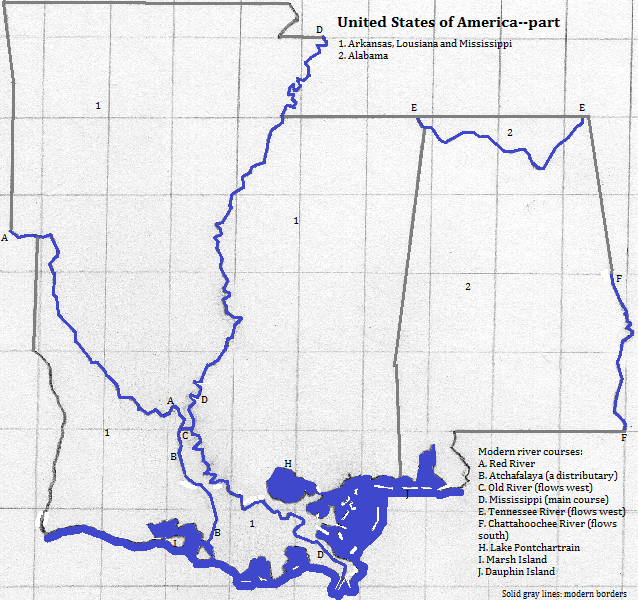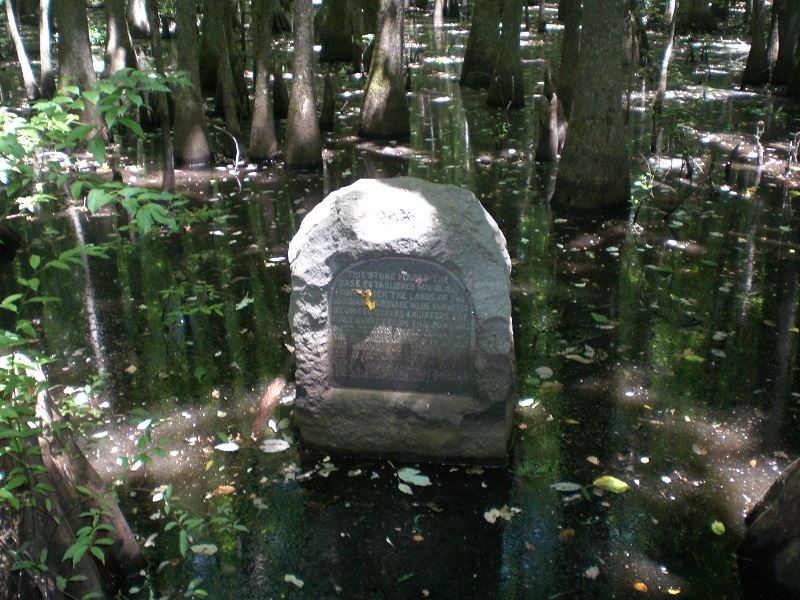
| To Duval Family Home Page | North America | Anglo-North America |
| To Chris Home Page | United States of America | |
| To Earth (Geography Home Page) |
These four states divide into four of their nation's geophysical zones. First, in Arkansas's northwest are the Ozark Plateaus. Second, the rest of Arkansas, plus all of Lousiana and Mississippi and southern, and most of western, Alabama are part of the Atlantic Coastal Plain. This is divided into the West Gulf Plain in southwest Arkansas and western Louisiana; the Mississippi Alluvial Plain following the river north to south; and the East Gulf Plain farther east. Here is the lower course of the Mississippi River, which has two deltas, the huge irregular delta along the shore and its interior Delta just south of where the Arkansas adds its waters.
The third fundamental division, in northwestern Alabama, is the southernmost reach of the Highland Rim Section of the Interior Low Plateaus, part of the Interior Plains.
The final division constitutes the Appalachian Highlands in northeastern Alabama. These are divided into three bands that start here and head northeast: the Cumberland Plateau Section of the Appalachian Plateaus; the Tennessee Section of the Valley and Ridge Province; and the Piedmont Upland Section of the Piedmont Province.

These states are in the part of North America in which English-speakers and Christians are the majority.
New Orleans in Lousiana, and Birmingham in Alabama are the only large cities.
The Haynesville Shale, a gas field, is in southwest Arkansas, northwest Louisiana and beyond this area in eastern Texas. In these states was one group and several other languages that are sometimes said to combine with Algonquian languages, Wiyot and Yurok into a larger assembly. The local ones are the Muskogean Group--here represented by Choctaw, Alabama, Koasati and Creek--plus the isolates: Natchez, Atakapa, Chitimacha and Tunica. One local religion was the Natchez royal cult and sun worship. The Natchez were the last representative of a mound-building culture in the Mississippi valley, but--unlike those of their immediate predecessors--Natchez religious objects do not indicate a focus on death. The Choctaw and the Creek were forcibly removed to Oklahoma by a southern U.S. warlord, later elected president for his popular genocide. Siouan languages such as Quapaw were spoken in all but southwest Arkansas. In southwest Arkansas Caddo, one of the Caddoan languages, was spoken. The French were the first Europeans in the area, traveling by waterways. English-speakers arrived along the Atlantic coast, moved westward into northern Mississippi and Alabama, coerced the Spanish claims to parts of the coast, bought the claim to Louisiana and Arkansas from the Spanish who had acquired it from the French, and subsequently violently displaced the indiginous inhabitants. Eventually the majority of the inhabitants in large parts of this area were slaves, descended from Africans. Tourists visits the Melrose Plantation, which was an estate owned for a time by "Croles of Color," people of mixed African and French descent. north of Arkansas 1. There is some spillover into Arkansas of the Memphis, Tennessee, metropolitan area.Who was there before?

Surveying marker in a swamp, Louisiana Purchase State Park, Arkansas, United States of AmericaAround the Area
north of Alabama and Mississippi
east
south of most of Alabama
south of Louisiana, Mississippi and Mobile Bay
west of Arkansas
west of Louisiana
Footnotes
2. http://en.wikipedia.org/wiki/Haynesville_Shale, accessed 3/19/2014.
3. The relocations included intentionally inadequate food and blankets, a forced pace and cholera epidemics.